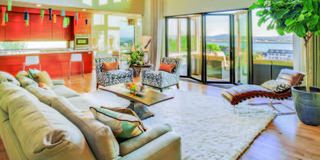
Spacious bright living room with high ceiling and fireplace.
In a world where design trends change with the seasons and technology evolves at a rapid pace, the desire for a home that will stand the test of time remains a universal dream.
Everyone envisions a spacious, well-lit home with enduring charm that won't go out of style.
Brendah Gitonga, an architect at Cubes and Beyond, and Georgina Achieng', a stylist specialising in residential interior design, offer valuable insights on how to achieve this elusive quality.
Brendah highlights the importance of combining functionality with aesthetic appeal, and drawing on cultural values while ensuring that designs adapt to future needs. As for Georgina, who combines her expertise in fashion with interior design, emphasises the role of quality, classic elegance and a personal touch in creating spaces that feel both timeless and personal. Together, their perspectives reveal how the integration of thoughtful design elements, rooted in both local traditions and modern sensibilities, can create environments that are visually captivating and enduringly practical for generations to come.
Georgina Achieng, 31 Events, Fashion and Interior Stylist)

Georgina Achieng'.
What key elements define a timeless interior design?
The key elements boil down to a few fundamental principles that I've come to appreciate over time. First and foremost, quality and classic elegance are vital. While trends come and go, detailed or ornate objects tend to endure. True quality speaks for itself—pieces that are crafted with longevity in mind really do stand out, whether it’s furniture, fabric, or ceramics. Quality has a way of shining through and creating something captivating that withstands ever-changing tides of fashion. That's why antiques and vintage items often embody timelessness; their designs hold strong no matter what the trends dictate.
Another crucial aspect is the use of textures and materials. Mixing textures creates depth and intrigue in a space, especially when working with neutral colours. The other one is strategic lighting. Large, arched windows are a dream for any space, letting in ample natural light and creating an inviting openness. Symmetry and balance are also vital for creating a calm, sophisticated, and welcoming space. Whether it’s how the furniture is arranged or how patterns are used, maintaining symmetry gives the room an air of intentionality. I find that classic patterns like damask, plaid and stripes have a timeless look, and when balanced correctly, elevate the space without feeling overwhelming. Also, colour and contrast play another key role in timeless design. Colours, like other design elements, go through cycles of popularity, but it’s how they are used that determines whether a room will stand the test of time. A versatile colour palette that mixes bold, bright hues with softer, muted tones allows the space to feel fresh yet enduring. Dark wood tones, greenery, and thoughtful accents all help to create focal points without overwhelming the room.
Are there specific materials or textures that never go out of style?
A few immediately come to mind. Marble and natural stone have been popular for centuries, and I believe they’ll always remain timeless. From kitchen and bathroom tiles to countertops and decor, marble is a safe bet. It’s elegant, durable, and has a natural beauty that’s hard to beat. Natural rugs are another favourite of mine. Materials like sisal and jute are not only classic but incredibly durable, especially for high-traffic areas. They age beautifully and are perfect for layering with vintage rugs—another timeless element that adds character to any room. The combination of these natural textures feels effortlessly chic and grounded, making them a staple in my decor. I also have a deep appreciation for classic or vintage wood furniture. Pieces with traditional or simple lines just have a way of sticking around, no matter what trends come and go. The same goes for hardwood floors—they’re always in style and lend warmth and sophistication to a space.
When it comes to bedding, I always opt for white. There’s something about crisp, clean white bedding that feels so timeless. It’s incredibly versatile too—you can easily layer it with textures, colours, or patterns to add personality without losing that classic, fresh look.
Gilded frames or vintage frames are another timeless favourite of mine. Whether it’s framing artwork or a mirror, an ornate gilded frame brings a touch of classic elegance that never feels outdated. Then there’s terracotta, which, like marble, has this timeless appeal. From tiles to planters, terracotta ages in such a beautiful way. It’s warm and earthy, and I know it will always have a place in my home. And lastly, I’m a big believer in investing in vintage and timeless glassware. Whether it’s cocktail glasses, decanters, or everyday water and wine glasses, a beautiful set of glassware is something I’ll always appreciate.
What common design mistakes should home owners avoid to achieve this balance?
As a homeowner, I believe that creating a space that’s both functional and timeless starts with focusing on lasting elegance rather than just following today’s trends. It’s important to invest in quality design that will resonate with generations to come, otherwise, a trendy home often ends up needing constant renovations, which isn’t sustainable in the long run. I also think it’s crucial to have a layout that makes sense and flows seamlessly from one room to the next—functionality and comfort are just as important as beauty. When it comes to colour, timeless design doesn’t have to mean sticking to whites and neutrals. You can be bold with colours, fixtures, and accessories, as long as they have a lasting appeal. I love incorporating vintage finds and Parisian elements like French doors, mouldings, and even pocket doors, which serve dual purposes in small spaces. Kitchens and bathrooms are two key areas where function meets style. I’m a big fan of breakfast nooks and the idea of using vintage dressers as bathroom vanities—they add character and practicality. In the end, it’s all about being intentional and taking your time to curate a space that reflects your style while standing the test of time.

Spacious bright living room with high ceiling and fireplace. Furnished with comfortable sofa and rocking chair.
How does timeless design impact property value, and is it something that potential home buyers in Kenya look for?
Timeless design boosts property value and is worth the investment for home buyers in Kenya. We've all seen people flip old homes and sell them for huge profits. The key is quality, time, and passion. Instead of following the same old trends, dare to do something different and stand out!
Brendah Gitonga, 29 Architect at Cubes and Beyond

Architect Brendah Gitonga gestures during the interview on September 20, 2024.
What defines timeless architecture in your view?
Timeless architecture, much like style in fashion, stays true to its character and fully embodies the essence of the space. It never feels underwhelming, overwhelming, or out of place. Despite the passing of time, whenever you step into such a space, it feels youthful—almost ageless.
How can architects balance functionality with a timeless aesthetic when designing homes?
Timelessness is shaped by the opinions and preferences of those who interact with a space. With this in mind, I believe a design should reflect the traditions and values of the people it serves and the land it inhabits. The aesthetics need to incorporate elements of local culture, acknowledging the perspectives of past, present, and future generations. Striking a balance between what mattered before, what’s important today, and what will be relevant in the future—especially regarding usability and sustainability—creates harmony.
What are the key considerations when planning for both present and future needs?
It is essential to balance immediate functionality with long-term adaptability. A design should serve users effectively now while remaining flexible for future changes. Key factors include sustainability, making sure the space is eco-friendly and resilient, and cultural relevance, reflecting traditions while adapting to societal shifts. Integrating technology, ensuring usability, and prioritising durability are also crucial. By considering these elements carefully, a design can stay practical, relevant, and timeless for generations to come.
In terms of materials, what choices contribute to a design that stands the test of time?
When it comes to materials, choices really depend on the location. Climate, local materials, cultural significance, and the space’s purpose all play a role. For instance, building a glass house in Tharaka could be visually striking, like a monument. But if it's meant to function as a community hub, it might not be practical. You'd probably need thick masonry or brick walls to shield the glass from the intense heat, ensuring the space is comfortable and usable. It’s all about balancing aesthetics with functionality.
How do local and sustainable materials play a role in creating lasting designs?
I believe local and sustainable materials are key to creating lasting designs. They adapt to the local climate, reflect cultural relevance, and minimise environmental impact. By using materials native to the region, we ensure they’re suited to local weather and support cultural traditions, while also reducing the carbon footprint from transportation. Sustainable materials, like recycled or reclaimed resources, help lower waste and energy consumption. Integrating these elements not only enhances a building’s durability and functionality but also strengthens its connection to the surroundings, making the design meaningful and practical for the long term.
What architectural elements or features are consistently present in homes that retain their appeal over decades?
I’ve always admired design elements like large windows, sunken lounges, double volumes, and recessed walls. They’ve been cherished since the early 20th century and for good reason—they’re timeless. Their enduring appeal comes from how they enhance spatial interaction and capture the essence of a place. These features create a seamless connection between indoor and outdoor environments, inviting natural light to flood in and fostering a sense of openness and continuity. The way they impact both the atmosphere and functionality of a space is why they remain such lasting staples in architecture.
How do you incorporate cultural or traditional Kenyan influences into timeless house designs?
I’m drawn to design elements that mimic traditional houses—like thatched or pitched roofs and the use of branches and tree stumps in building elevations. These features take inspiration from Agikuyu mud huts, blending tradition with modernity. You can see this mix beautifully in contemporary cottages in Tsavo or estates like Migaa Golf Estate, which remind us of our African heritage in the midst of modern architecture. Inside, adding artefacts and textures like Maasai shuka patterns, Akamba basket weaving, and tribal beading can create memorable feature walls, much like those in Sarova Hotels. This approach infuses modern spaces with the timeless craftsmanship of our traditions.
What role do natural light and ventilation play in creating homes that feel timeless?
Strategic placement of openings can capture light and air in a way that animates a space and establishes its unique ‘genius loci.’ When executed well, this approach imparts a timeless quality to the space. For instance, the Basilica in Nairobi CBD and many early churches used this technique to create environments that feel spiritually uplifting and ‘heavenly.’ This thoughtful design harnesses natural elements to infuse the space with enduring character and appeal.
Are there specific techniques or layouts you recommend to maximise these elements?
To maximise light and air in my home and achieve a timeless feel, I’d focus on strategic window placement—using larger or floor-to-ceiling windows and skylights to capture and distribute natural light. An open floor plan would allow light and air to flow freely, while well-placed windows and vents would ensure cross-ventilation for fresh air circulation. Light-reflecting surfaces, like lighter paint colours and polished floors, can enhance brightness. I’d also integrate outdoor spaces by adding sliding glass doors or courtyards to connect the indoors with nature. Adjustable shading devices and thermal mass materials would help regulate temperature, and architectural elements like vaulted ceilings and atriums could further improve the overall light and air dynamics.
Are there specific designs that fit Kenya’s diverse climates and landscapes?
Design acts like a language, adapting to different regions based on materials, purpose, and user preferences. On the Swahili coast, designs focus on enhancing thermal comfort and reflecting Swahili culture, adapting to the hot climate. In urban areas like Nairobi, the focus shifts to optimising land use and reducing pollution. Coastal homes benefit from large windows and shaded spaces to manage heat, while highland regions use insulation and expansive windows for cooler temperatures. The Rift Valley needs thermal mass and courtyards for temperature swings, and arid areas rely on thick walls and rainwater harvesting. In cities, vertical designs, sustainable systems, and green spaces address density and environmental impact. This approach ensures that each design is tailored to its environment.
What advice would you give to someone planning to build a home that will remain aesthetically pleasing for generations?
To create a unique identity for a space, I focus on the core elements that define its character and feel. It’s essential to find professionals who share this vision and are committed to bringing it to life. By doing this, the space will keep its essence and unique character over time.
How does timeless architecture impact a home’s long-term property value, especially in the Kenyan market?
Timeless architecture can greatly boost a home’s long-term value, especially in the Kenyan market. Classic designs, quality materials, and local architectural elements maintain appeal as trends shift. Sustainable practices and adaptable designs add both environmental and financial value, making the property attractive to future buyers. In a market that values both modern functionality and traditional charm, timeless architecture is a smart investment.
Share examples of timeless buildings or homes in Kenya that continue to inspire architects today.
The Kenyan Parliament's tribal and figurative façade remains a strong symbol of authority and originality. The Zamani Business Park on Ngong Road set a new standard for office design in Nairobi with its innovative functionality. The Koitobos Residence, designed by Evans Makan, blends traditional African hut elements with modern living. Each of these structures exemplifies timeless architecture, maintaining unique character while influencing contemporary design in Kenya.
What challenges do you face when trying to incorporate modern trends into designs that aim for timelessness?
I need to balance trendy elements with classic aesthetics, ensuring modern materials and technologies blend seamlessly with enduring qualities. Cultural sensitivity is crucial; as contemporary trends must respect traditional contexts. I also have to manage functionality, aesthetics, and client expectations, ensuring modern sustainable practices enhance rather than detract from timeless appeal. Choosing modern elements that age gracefully and require minimal upkeep is key. Navigating these challenges ensures a design that remains relevant and enduring over time.












